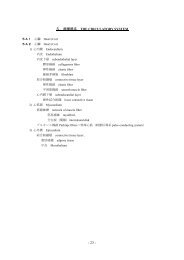Program / Abstract Book - KMU WWW3 Server for Education ...
Program / Abstract Book - KMU WWW3 Server for Education ...
Program / Abstract Book - KMU WWW3 Server for Education ...
Create successful ePaper yourself
Turn your PDF publications into a flip-book with our unique Google optimized e-Paper software.
No. 18 (PC 18)<br />
IODINE STATUS AMONG THE SCHOOL CHILDREN OF HILLY AND PLAIN<br />
REGION OF EASTERN NEPAL<br />
Baral N 1 , Khatiwada S 1 , Shakya PR 1 , Sah GS 2 , Gelal B 1 , Das BKL, Lamsal M 1<br />
1 Department of Biochemistry, 2 Department of Pediatrics and Adolescent Medicine, B. P. Koirala<br />
Institute of Health Sciences, Dharan, Nepal<br />
Introduction: Iodine deficiency is a leading cause of preventable mental retardation in the world today<br />
affecting 19.4% population of Nepal. It is particularly affect the developing brain of fetus and neonates.<br />
The geographical situation and poor accessibility of adequately iodized salt are the main cause of iodine<br />
deficiency in our country. Urinary iodine excretion (UIE) reflects current iodine intake and salt iodine<br />
content explore the level of iodine in household level.<br />
Objective: To assess the iodine status of the school children in Eastern Nepal.<br />
Materials and methods: A community based study was conducted on twelve districts of the Eastern<br />
Nepal representing hilly (Taplejung, Panchthar, Ilam, Dhankuta, Tehrathum and Sankhuwasabha) and<br />
plain region (Jhapa, Morang, Sunsari, Saptari, Siraha and Udayapur) on January 2008 to January 2012.<br />
A total of 4525 primary school children (6-12 years) were enrolled in the study and equal numbers of<br />
salt and urine samples were collected <strong>for</strong> the assessment of iodine status. UIE was measured by<br />
ammonium-persulphate digestion microplate (APDM) method and salt iodine content by semi<br />
quantitative rapid test kit.<br />
Results: Our study showed that 583 (12.9%) of school consumed open salt whereas 3942 (87.1%)<br />
consumed packet salt. Majority (86.7%) of school children consumed adequately iodized salt but 10.2%<br />
consumed inadequately iodized salt and 1.1 % children consumed salt with no iodine. The median UIE<br />
of the all school children is 241.08µg/L indicate the adequate iodine nutrition but still 13.1% children<br />
were suffering from some degree of iodine deficiency.<br />
Conclusion: Based on the result we conclude that iodine status of the school children in Eastern Nepal<br />
is improving but continuous monitoring of the population is necessary <strong>for</strong> the sustainable elimination of<br />
iodine deficiency disorders (IDD) from the country and prevention of iodine induced diseases.<br />
- 71 -



